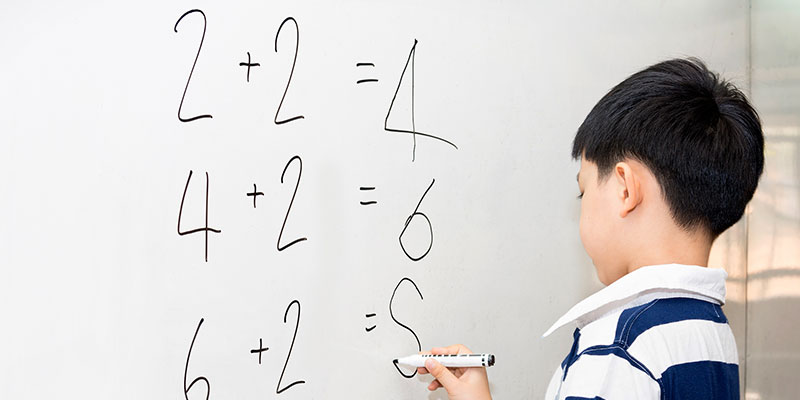PSLE is the short form for the Primary School Leaving Examination, one of the important national-level examinations that every Singapore student has to take. PSLE is conducted at the end of the six years of primary school, and it determines the stream a student will pursue in their higher studies. This will be the first national exam a child will appear, so parents also have to support them and make them score high. Mathematics is a very important subject which is of great use in everyday life in some form or the other. PSLE Math exam and syllabus teach sixth-grade students- thinking, problem-solving and analysing skills. Let us now learn about the PSLE Math format, learning objectives, and scoring patterns.
Importance of the Subject Mathematics
Mathematics is applied everywhere. It is used to calculate expenses, plan home renovations, and study engineering. Mathematics in PSLE uses concepts to make students analyse complicated problems, think logically and solve them efficiently. PSLE Math syllabus is rigid; however, it is very helpful to develop the candidates mentally. Mathematics is taught with extensive formulae and various problem-solving methodologies. The need for students to learn Maths is that the abstract concepts help students visualise a problem, understand and come up with substantial evidence to get the right answer.
The difficulty level of any syllabus is sure to progress with every higher grade as students progress in their educational journey. Mathematics is essential to excel and gain mental discipline in our day-to-day lives for better cognitive rigour and logical reasoning. By building a familiarity with different topics in Mathematics, a child's confidence level increase which eventually help them feel comfortable while appearing for their PSLE Math examination. With the foundation Math PSLE, a student will be able to face life better in the long run.
Also Read : Difference Between PSLE Foundation Math & Standard Math
An Overview of PSLE Mathematics
Learning Objectives
The main purpose of primary Mathematics, according to MoE, is to open the opportunities for students to pursue Maths in higher studies. With PSLE Maths examinations, primary class 6 students must meet the three broad aims of the syllabus. They are:
- Number & Algebra – This performs straightforward calculations and algebraic procedures.
- Geometry & Measurement – This applies the mathematical concepts in several contexts.
- Statistics – This analyses the information, selects appropriate strategies and makes inferences to solve the problems.
PSLE Mathematics focuses on teaching the students to grow with essential skills, concepts, attitudes, metacognition and processes in daily functions. With the improvement in technology, students must be thorough with the basic Maths concepts to make constant split-second decisions.
Looking forward to taking PSLE exams to finish your child's primary education? Choose the right PSLE online learning app for your children to feel comfortable during exam preparation. StudySmart's AI based self-learning techniques enable students to acquire deep knowledge in: PSLE English, PSLE Maths, PSLE Science.
Foundation PSLE Mathematics
The foundation Mathematics examination assesses the student's achievement in Maths with respect to the objectives of the syllabus. Let us now discuss the objectives of the foundation Maths in students. They are:
- Recalling the mathematical concepts, facts, formulae, and rules to perform the necessary calculations easily.
- Interpreting, understanding and applying mathematical skills and concepts in various contexts.
- Reasoning out, analysing the information and making essential inferences to different situations.
The skills and concepts newly introduced in foundation Mathematics are a category of the standard Maths syllabus.
PSLE Mathematics Syllabus
PSLE Mathematics syllabus teaches students the concepts in Maths to use in their daily lives. These help students to prepare for their secondary school physics and Mathematics. There are nine topics under numbers and algebra, measurements and geometry and statistics subjects. They are:
- Whole Numbers
- Fractions
- Decimals
- Percentage
- Measurement
- Data analysis
- Geometry
- Ratio
- Speed
Foundation Mathematics teaches students how to solve a problem under different circumstances, similar to the standard PSLE Maths syllabus.
PSLE Maths Examination Format
The PSLE Math format in examinations includes two papers which a student will be writing on the same day. They will have one hour's break between the test and each section contains the following topics.
1. Paper Format for PSLE Maths & PSLE foundation Maths
The format for the PSLE Maths examination is:
- Paper 1A contains multiple-choice questions for 20 marks with a weightage of 20%. Paper 1B contains short answer questions for 25 marks with 25% weightage. The total duration is one hour.
- Paper 2 contains short answer questions for 10 marks and structured or long answer questions for 45 marks. The short answers have a weightage of 10%, and the long answers have a 45% weightage. The total time duration is one and a half hours.
Thus, all these sums up to 100 marks for two and a half hours. The foundation Mathematics also contains two papers and works in the same manner mentioned above. However, the format varies a little.
- Paper 1A contains multiple-choice questions for 30 marks with 33.4% weightage. Paper 1B contains short answer questions for 20 marks with 22.2 % weightage, and both are for one hour.
- Paper 2 contains short answers for 20 marks with 22.2% weightage and long answer questions for 20 marks with 22.2% weightage, and the duration to finish it is one hour.
Thus, there are 90 marks for two hours and 100% weightage.
2. PSLE Mathematics Paper Booklets
The candidates taking the PSLE Maths exam have to appear for two papers. Let's see them in elaboration here.
Maths Paper 1
The PSLE Maths paper 1 contains two booklets. They are booklet A and booklet B, which assess the mathematical concepts in terms of short and long answer questions. However, no calculators are permitted. Booklet A is for 20 marks and has 12 multiple-choice questions, of which 10 of them are one-mark questions and 5 are two-mark questions. These questions test the mathematical skills and conceptual understanding of a student. Booklet 2 is for 25 marks with 15 short answer questions, out of which 5 are one-mark questions, and 10 are two-mark questions. Here, the students are expected to show their solving methods and provide unit in all their answers.
Maths Paper 2
PSLE Maths paper 2 contains 17 questions, out of which 5 are short-answer questions with two marks each and 12 long-answer questions with 3 to 5 marks each. The entire paper has to be finished in ninety minutes. Students can use calculators for this examination and must show the solving methods clearly beside every question. Examiners grade the students with better scores based on methods they use to solve problems. Students have to mention the final answers in the allotted space and provide units similar to paper 1.
3. Calculators Approved for PSLE Mathematics & PSLE Foundation Mathematics
Scientific calculators of a specific model are allowed, and students must carry them for their PSLE Maths paper 2 exams. However, the calculators must not have any graphing or programmable functions.
Difference Between PSLE Foundations & Standard PSLE Mathematics
The differences between a standard PSLE Maths and Foundations Maths are:
- Foundation Maths has reduced requirements to understand and master the mathematical concepts and skills to solve problems.
- Both the Maths have the same papers in exams but with less difficulty and scope.
As a result, students learn to focus their resources and time to build a strong foundation for Maths. The syllabus prepares them with sufficient knowledge to learn Maths at a higher level efficiently in the future.

A Complete Guide on PSLE Maths Dates, Exam Preparation & Scoring Pattern
The PSLE Maths examination is an important exam and so keeping track of the examination dates is necessary to plan and prepare better. The dates for PSLE Maths are as follows.
- Maths Paper 1 – October 2nd, 8:15 AM
- Maths Paper 2 – October 2nd, 10:30 AM
- Foundation Maths Paper 1 – October 2nd, 8:15 AM
- Foundation Maths Paper 2 – October 2nd, 10:30 AM
PSLE Maths assesses the student's problem-solving skills and critical thinking ability to recall the mathematical formulae, concepts, facts, and rules to perform the computations. The candidates need to understand, reason out, analyse and interpret the information with the appropriate strategy. As there are multiple-choice, short-answers and long-answers questions in the PSLE Maths examination, every student will take up the exams for two and a half hours.
PSLE Scoring Pattern
The PSLE scoring system is followed in both foundation and standard PSLE subjects. As per the new grading system, there are achievement levels which are eight different PSLE scoring bands for the standard PSLE subjects.
PSLE Mathematics Preparation Tips
Maths is a subject that is conceptual with heavy application. It helps students understand and gain a special ability to apply the learnt theories in real life through their entire learning process. Let us discuss a few tips on how to prepare for a PSLE Maths exam.
Analyse & Work on Mistakes
Students have to prepare themselves in a way that they do not commit errors as it is very common in Maths. A small mistake will give a wrong final answer and affect the score. Therefore, students have to work with careful analysis to avoid mistakes. There are various types of mistakes, namely, technical, conceptual and procedural. Technical mistakes are the ones committed due to wrong calculations. Conceptual mistakes occur because of an incomplete understanding of the Maths idea and concept. Procedural mistakes happen when students do not know how to solve a sum stepwise.
Revise & Plan
There are a wide range of topics in the primary maths syllabus. A student needs to plan early to have ample time to revise the topics and become thorough with the concepts before appearing for the exam. Doing so makes the candidates combat the exam fear with less anxiety.
Prepare a Maths Dictionary
The primary Maths syllabus has a lot of complicated terminologies. Preparing notepads or flashcards to remember the important points will help the students revise for examinations effectively. Candidates can include the sample answers and definitions for referring and learning.
Move Out of Comfort Zone
It is the natural tendency for students to answer the simple questions first and the complex questions later. There is no benefit in taking up the simple questions initially, so students must be encouraged to get out of their comfort zone and start answering the questions either in its order or spend more time on the difficult ones as primary move. By working on the difficult questions first, students will concentrate better to solve them and increase the chance of getting them right.
The Takeaway
Practice makes a student perfect! In order to excel in primary Maths, the students must make consistent practice and gain a strong foundation to grasp the entire subject properly. Students must understand that the learning process is as important as the learning outcome. Studysmart based in Singapore has the best tutors and resources to prepare you with a solid foundation in Maths with which you will be able to correlate and apply them to real-life scenarios effortlessly.
